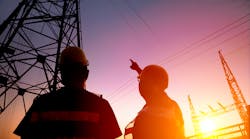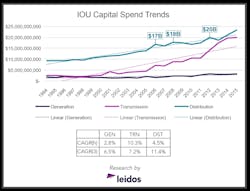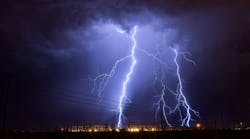Grid Hardening & Resiliency, a new Leidos white paper by Alyson Rossini and Jeffrey Richard, discusses grid hardening measures utilities are taking to proactively strengthen infrastructure and minimize system downtime.
As the authors point out, it is clear, when aging infrastructure is coupled with severe weather, that the resulting outages can be a massive expense for utilities. Depending on the number of customers that lose power, a single storm can cost between $500,000 to more than $1 billion.
And state commissions and local government are putting pressure on utilities to increase reliability before, during, and after storms, thus driving a more urgent need for grid hardening.
According to the U.S. Department of Energy, between 2003 and 2012 weather events caused nearly 680 power outages, each affecting at least 50,000 customers.
The Leidos white paper includes references to a study of FERC Form 1 data from investor-owned utilities across North America, in which Leidos identified increases in capital T&D spending during years of major storms.
The spikes in historical spend in years 2005, 2008, and 2012 correlate with some of the country’s most significant storms—Hurricane Katrina, Hurricane Ike, and Superstorm Sandy, respectively.
The paper also highlights how there must be a balance in protecting the infrastructure, hardening components, reducing the impact of storms, and expediting repairs. Grid modernization is a supplement to hardening. It involves upgrading the system to use cutting-edge technology or newer components that are often linked to each other through advanced communication or automated systems.
Resiliency can be defined by two categories, general readiness and storm-related readiness:
- General readiness by electric utilities might include improving communications and preparedness training, regular power line inspection and maintenance, and vegetation management to remove tree limbs posing a risk for outages during a storm. It also includes proactively identifying the worst performing feeders, reviewing circuit configuration and back up, and replacing assets at the end of their useful life.
- Storm-related readiness focuses on ensuring that emergency measures are ready to deploy in the immediate aftermath of a storm. It might involve establishing fuel contracts for vehicles, pre-staging materials, developing a plan for crews, or developing a storm restoration or response app for smart phones.
When considering the “grid of tomorrow”, microgrids may be a solution in the near future to reduce the duration of outages and ensure public safety, especially in areas where feeder back up is not an option. They have been evolving from a diesel generator to restore power to a single customer to smart systems that may incorporate renewables and battery storage.
An Edison Electric Institute report on grid hardening states, “There is no one solution to hardening the infrastructure or creating a more resilient system. Rather, utilities and their regulators must look at the full menu of options and decide the most cost-effective measures to strengthening the grid and responding to storm damages and outages.” Each utility must identify hardening techniques specific to its needs.
More information on the Leidos white paper is available at this link.



